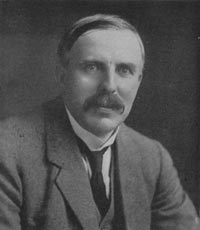
| Born: Aug 30, 1871 in Brightwater, New Zealand |
| Died: Oct 19, 1937 (at age 66) in Cambridge, England, UK |
| Nationality: British, New Zealand |
| Famous For: Father of nuclear physics, Rutherford model, Rutherford scattering, Rutherford backscattering spectroscopy, Discovery of proton, Rutherford (unit) and Coining the term ‘artificial disintegration’ |
| Awards: Rumford Medal (1905), Nobel Prize in Chemistry (1908), Elliott Cresson Medal (1910), Matteucci Medal (1913), Copley Medal (1922) and Franklin Medal (1924) |
Ernest Rutherford was a Nobel Prize winning famous physicist who was born in New Zealand in 1871. He was the son of a Scottish-born father and English-born mother. He was a bright student at school and won a scholarship to the University of New Zealand. There he graduated with Arts and Science degrees, and then won a scholarship to the Cavendish Laboratory at Cambridge University in 1895.
Teaching posts
He had a distinguished spell at Cavendish where he pioneered new techniques in the detection of radio waves and made discoveries about the structure of atoms and the nature of radiation. He moved to Montreal, Canada in 1898 when he was appointed to a teaching post at McGill University. Two years later, he married his long time fiancé Mary Newton. In 1907, he returned to Britain when he was appointed Professor of Physics at Manchester University.
In 1917, he returned to the Cavendish Laboratory when he was appointed Professor of Physics. He held this position until his death in 1937. During his tenure of the physics chair at the Cavendish, the Laboratory went through an astonishingly productive period in research physics with many of his staff becoming recipients of Nobel Prizes.
Work on the Nature of Radiation
During his initial time at the Cavendish, Rutherford was nurtured by the physics professor J.J. Thomson. When he moved to Canada, he carried on his research in radiation, and discovered the difference between alpha and beta radiation. He was also the first physicist to realize that atoms could change from one element to another as a result of decay through radioactivity. Rutherford discovered that elements have a half-life. This is a time period during which a quantity of a radioactive element will diminish or decay by 50%. In recognition of this groundbreaking work, Rutherford was awarded the Nobel Prize in 1908. Somewhat bizarrely, the Nobel foundation awarded him the chemistry rather than the physics prize.
Atomic Structure
In 1911, while working in Manchester, Rutherford was experimenting on the effects of firing particles at various substances. His experiments showed that when firing alpha particles at a sheet of gold foil, most of the particles passed through the sheet. However, some were bounced back. This led Rutherford to propose that the bounced particles must be colliding with objects of high mass. He concluded that atoms must have a dense, positively charged nucleus surrounded by negatively charged, less dense electrons and he proposed a new theory about the structure of an atom.
Splitting the Atom
Perhaps Rutherford is best known to the public as the first man to split an atom. This is strictly incorrect, because atoms are split during chemical reactions. In his experiments in radioactive decay, Rutherford had already recognized that atoms may split spontaneously. What Rutherford actually managed to do in 1932 was split the nucleus deliberately.
Honors
Rutherford received many awards and honors during his lifetime. In 1931, he was given the title “Baron Rutherford of Nelson.” When he died in 1937, he was buried in Westminster Abbey, where Newton is also buried, an honor awarded to only the most distinguished scientists.